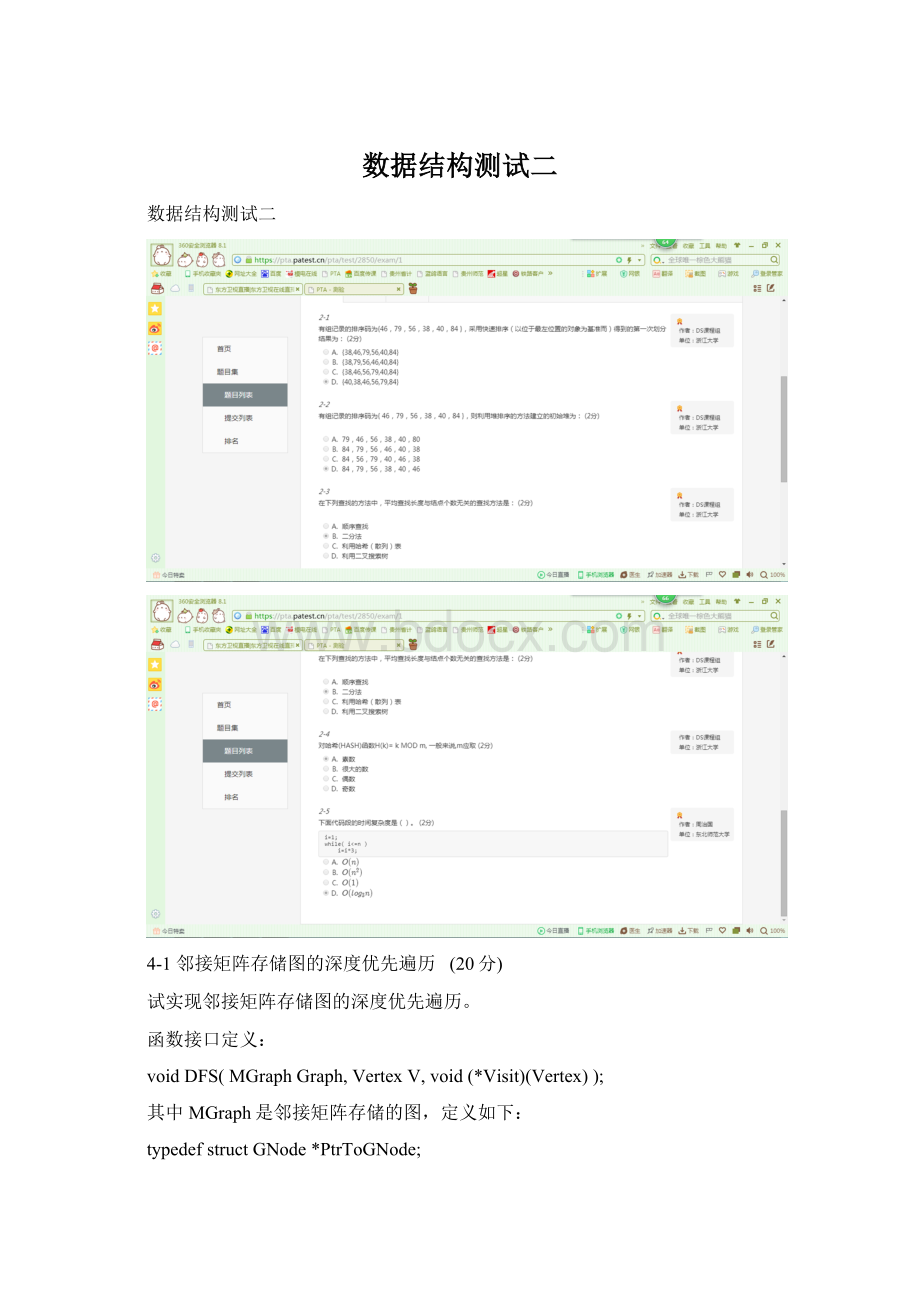数据结构测试二.docx
《数据结构测试二.docx》由会员分享,可在线阅读,更多相关《数据结构测试二.docx(17页珍藏版)》请在冰豆网上搜索。

数据结构测试二
数据结构测试二
4-1 邻接矩阵存储图的深度优先遍历 (20分)
试实现邻接矩阵存储图的深度优先遍历。
函数接口定义:
voidDFS(MGraphGraph,VertexV,void(*Visit)(Vertex));
其中MGraph是邻接矩阵存储的图,定义如下:
typedefstructGNode*PtrToGNode;
structGNode{
intNv;/*顶点数*/
intNe;/*边数*/
WeightTypeG[MaxVertexNum][MaxVertexNum];/*邻接矩阵*/
};
typedefPtrToGNodeMGraph;/*以邻接矩阵存储的图类型*/
函数DFS应从第V个顶点出发递归地深度优先遍历图Graph,遍历时用裁判定义的函数Visit访问每个顶点。
当访问邻接点时,要求按序号递增的顺序。
题目保证V是图中的合法顶点。
裁判测试程序样例:
#include
typedefenum{false,true}bool;
#defineMaxVertexNum10/*最大顶点数设为10*/
#defineINFINITY65535/*∞设为双字节无符号整数的最大值65535*/
typedefintVertex;/*用顶点下标表示顶点,为整型*/
typedefintWeightType;/*边的权值设为整型*/
typedefstructGNode*PtrToGNode;
structGNode{
intNv;/*顶点数*/
intNe;/*边数*/
WeightTypeG[MaxVertexNum][MaxVertexNum];/*邻接矩阵*/
};
typedefPtrToGNodeMGraph;/*以邻接矩阵存储的图类型*/
boolVisited[MaxVertexNum];/*顶点的访问标记*/
MGraphCreateGraph();/*创建图并且将Visited初始化为false;裁判实现,细节不表*/
voidVisit(VertexV)
{
printf("%d",V);
}
voidDFS(MGraphGraph,VertexV,void(*Visit)(Vertex));
intmain()
{
MGraphG;
VertexV;
G=CreateGraph();
scanf("%d",&V);
printf("DFSfrom%d:
",V);
DFS(G,V,Visit);
return0;
}
/*你的代码将被嵌在这里*/
输入样例:
给定图如下
5
输出样例:
DFSfrom5:
5130246
(无答案)
4-5 顺序表操作集 (10分)
本题要求实现顺序表的操作集。
函数接口定义:
ListMakeEmpty();
PositionFind(ListL,ElementTypeX);
boolInsert(ListL,ElementTypeX,PositionP);
boolDelete(ListL,PositionP);
其中List结构定义如下:
typedefintPosition;
typedefstructLNode*List;
structLNode{
ElementTypeData[MAXSIZE];
PositionLast;/*保存线性表中最后一个元素的位置*/
};
各个操作函数的定义为:
ListMakeEmpty():
创建并返回一个空的线性表;
PositionFind(ListL,ElementTypeX):
返回线性表中X的位置。
若找不到则返回ERROR;
boolInsert(ListL,ElementTypeX,PositionP):
将X插入在位置P并返回true。
若空间已满,则打印“FULL”并返回false;如果参数P指向非法位置,则打印“ILLEGALPOSITION”并返回false;
boolDelete(ListL,PositionP):
将位置P的元素删除并返回true。
若参数P指向非法位置,则打印“POSITIONPEMPTY”(其中P是参数值)并返回false。
裁判测试程序样例:
#include
#include
#defineMAXSIZE5
#defineERROR-1
typedefenum{false,true}bool;
typedefintElementType;
typedefintPosition;
typedefstructLNode*List;
structLNode{
ElementTypeData[MAXSIZE];
PositionLast;/*保存线性表中最后一个元素的位置*/
};
ListMakeEmpty();
PositionFind(ListL,ElementTypeX);
boolInsert(ListL,ElementTypeX,PositionP);
boolDelete(ListL,PositionP);
intmain()
{
ListL;
ElementTypeX;
PositionP;
intN;
L=MakeEmpty();
scanf("%d",&N);
while(N--){
scanf("%d",&X);
if(Insert(L,X,0)==false)
printf("InsertionError:
%disnotin.\n",X);
}
scanf("%d",&N);
while(N--){
scanf("%d",&X);
P=Find(L,X);
if(P==ERROR)
printf("FindingError:
%disnotin.\n",X);
else
printf("%disatposition%d.\n",X,P);
}
scanf("%d",&N);
while(N--){
scanf("%d",&P);
if(Delete(L,P)==false)
printf("DeletionError.\n");
if(Insert(L,0,P)==false)
printf("InsertionError:
0isnotin.\n");
}
return0;
}
/*你的代码将被嵌在这里*/
输入样例:
6
123456
3
651
2
-16
输出样例:
FULLInsertionError:
6isnotin.
FindingError:
6isnotin.
5isatposition0.
1isatposition4.
POSITION-1EMPTYDeletionError.
FULLInsertionError:
0isnotin.
POSITION6EMPTYDeletionError.
FULLInsertionError:
0isnotin.
答案:
(10分)
ListMakeEmpty(){//置空
ListL;
L=(List*)malloc(sizeof(List));
L->Last=-1;
returnL;
}
PositionFind(ListL,ElementTypeX){
inti;
for(i=0;i<=L->Last;i++){//查找
if(L->Data[i]==X)
returni;
}
returnERROR;
}
boolInsert(ListL,ElementTypeX,PositionP){
if(L->Last+1==MAXSIZE){//若最后一个元素下标+1为max则顺序表已满
printf("FULL");
returnfalse;
}
if(0>P||P>(L->Last+1)){//插入位置必须大于等于0,或者小于等于Last+1
printf("ILLEGALPOSITION");
returnfalse;
}
for(inti=L->Last;i>=P;i--){//从后面开始移动
L->Data[i+1]=L->Data[i];
}
L->Data[P]=X;
L->Last++;
returntrue;
}
boolDelete(ListL,PositionP){
if(P<0||P>L->Last){//删除位置必须是[0,Last]之间
printf("POSITION%dEMPTY",P);
returnfalse;
}
else{
inti;
for(i=P;iLast;i++){
L->Data[i]=L->Data[i+1];
}
L->Last--;
returntrue;
}
}
4-5 在一个数组中实现两个堆栈 (20分)
本题要求在一个数组中实现两个堆栈。
函数接口定义:
StackCreateStack(intMaxSize);
boolPush(StackS,ElementTypeX,intTag);
ElementTypePop(StackS,intTag);
其中Tag是堆栈编号,取1或2;MaxSize堆栈数组的规模;Stack结构定义如下:
typedefintPosition;
structSNode{
ElementType*Data;
PositionTop1,Top2;
intMaxSize;
};
typedefstructSNode*Stack;
注意:
如果堆栈已满,Push函数必须输出“StackFull”并且返回false;如果某堆栈是空的,则Pop函数必须输出“StackTagEmpty”(其中Tag是该堆栈的编号),并且返回ERROR。
裁判测试程序样例:
#include
#include
#defineERROR1e8
typedefintElementType;
typedefenum{push,pop,end}Operation;
typedefenum{false,true}bool;
typedefintPosition;
structSNode{
ElementType*Data;
PositionTop1,Top2;
intMaxSize;
};
typedefstructSNode*Stack;
StackCreateStack(intMaxSize);
boolPush(StackS,ElementTypeX,intTag);
ElementTypePop(StackS,intTag);
OperationGetOp();/*detailsomitted*/
voidPrintStack(StackS,intTag);/*detailsomitted*/
intmain()
{
intN,Tag,X;
StackS;
intdone=0;
scanf("%d",&N);
S=CreateStack(N);
while(!
done){
switch(GetOp()){
casepush:
scanf("%d%d",&Tag,&X);
if(!
Push(S,X,Tag))printf("Stack%disFull!
\n",Tag);
break;
casepop:
scanf("%d",&Tag);
X=Pop(S,Tag);
if(X==ERROR)printf("Stack%disEmpty!
\n",Tag);
break;
caseend:
PrintStack(S,1);
PrintStack(S,2);
done=1;
break;
}
}
return0;
}
/*你的代码将被嵌在这里*/
输入样例:
5
Push11
Pop2
Push211
Push12
Push212
Pop1
Push213
Push214
Push13
Pop2
End
输出样例:
Stack2Empty
Stack2isEmpty!
StackFull
Stack1isFull!
PopfromStack1:
1
PopfromStack2:
131211
答案:
(20分)
StackCreateStack(intMaxSize){
StackS=(Stack)malloc(sizeof(structSNode));
S->MaxSize=MaxSize;
S->Data=(ElementType*)malloc(sizeof(ElementType)*MaxSize);
S->Top2=MaxSize;
S->Top1=-1;
returnS;
}
boolPush(StackS,ElementTypeX,intTag){
if(S==NULL)
returnfalse;
if((S->Top1+1)==S->Top2){
printf("StackFull\n");
returnfalse;
}
if(1==Tag){
S->Data[++(S->Top1)]=X;
returntrue;
}
elseif(2==Tag){
S->Data[(--S->Top2)]=X;
returntrue;
}
returnfalse;
}
ElementTypePop(StackS,intTag){
if(S==NULL)
returnERROR;
if(1==Tag){
if(-1==S->Top1){
printf("Stack%dEmpty\n",Tag);
returnERROR;
}
returnS->Data[(S->Top1)--];
}elseif(2==Tag){
if(S->MaxSize==S->Top2){
printf("Stack%dEmpty\n",Tag);
returnERROR;
}
returnS->Data[(S->Top2)++];
}
returnERROR;
}
4-7 学生成绩链表处理 (20分)
本题要求实现两个函数,一个将输入的学生成绩组织成单向链表;另一个将成绩低于某分数线的学生结点从链表中删除。
函数接口定义:
structstud_node*createlist();
structstud_node*deletelist(structstud_node*head,intmin_score);
函数createlist利用scanf从输入中获取学生的信息,将其组织成单向链表,并返回链表头指针。
链表节点结构定义如下:
structstud_node{
intnum;/*学号*/
charname[20];/*姓名*/
intscore;/*成绩*/
structstud_node*next;/*指向下个结点的指针*/
};
输入为若干个学生的信息(学号、姓名、成绩),当输入学号为0时结束。
函数deletelist从以head为头指针的链表中删除成绩低于min_score的学生,并返回结果链表的头指针。
裁判测试程序样例:
#include
#include
structstud_node{
intnum;
charname[20];
intscore;
structstud_node*next;
};
structstud_node*createlist();
structstud_node*deletelist(structstud_node*head,intmin_score);
intmain()
{
intmin_score;
structstud_node*p,*head=NULL;
head=createlist();
scanf("%d",&min_score);
head=deletelist(head,min_score);
for(p=head;p!
=NULL;p=p->next)
printf("%d%s%d\n",p->num,p->name,p->score);
return0;
}
/*你的代码将被嵌在这里*/
输入样例:
1zhang78
2wang80
3li75
4zhao85
0
80
输出样例:
2wang80
4zhao85
答案:
(16分)
structstud_node*createlist()
{
intn=0;
structstud_node*head,*p1,*p2;
head=NULL;
p1=p2=(structstud_node*)malloc(sizeof(structstud_node));
scanf("%d",&p1->num);
if(p1->num==0)
returnhead;
scanf("%s%d",p1->name,&p1->score);
while
(1)
{
n++;
if(n==1)
head=p2=p1;
else
p2->next=p1;
p2=p1;
p1=(structstud_node*)malloc(sizeof(structstud_node));
scanf("%d",&p1->num);
if(p1->num==0)
break;
else
{
scanf("%s%d",p1->name,&p1->score);
}
}
p2->next=NULL;
returnhead;
}
structstud_node*deletelist(structstud_node*head,intmin_score)
{
structstud_node*p1,*p2;
p1=p2=head;
while(p1)
{
if(p1->score{
if(p1==head)
{
p1=p1->next;
head=p2=p1;
}
elseif(p1->next==NULL)
{
p2->next=NULL;
}
else
{
p1=p1->next;
p2->next=p1;
}
}
else
{
p2=p1;
p1=p1->next;
}
}
returnhead;
}
4-5 逆序数据建立链表 (20分)
本题要求实现一个函数,按输入数据的逆序建立一个链表。
函数接口定义:
structListNode*createlist();
函数createlist利用scanf从输入中获取一系列正整数,当读到-1−1时表示输入结束。
按输入数据的逆序建立一个链表,并返回链表头指针。
链表节点结构定义如下:
structListNode{
intdata;
structListNode*next;
};
裁判测试程序样例:
#include
#include
structListNode{
intdata;
structListNode*next;
};
structListNode*createlist();
intmain()
{
structListNode*p,*head=NULL;
head=createlist();
for(p=head;p!
=NULL;p=p->next)
printf("%d",p->data);
printf("\n");
return0;
}
/*你的代码将被嵌在这里*/
输入样例:
1234567-1
输出样例:
7654321
答案:
(19分)
structListNode*createlist()
{
structListNode*p1,*head,*p2;
head=NULL;
intn=0;
p1=p2=(structListNode*)malloc(sizeof(structListNode));
scanf("%d",&p1->data);
while(p1->data!
=-1)
{
n++;
if(n==1)
p1->next=NULL;
else
p1->next=p2;
p2=p1;
p1=(structListNode*)malloc(sizeof(structListNode));
scanf("%d",&p1->data);
}
head=p2;
returnhead;
}